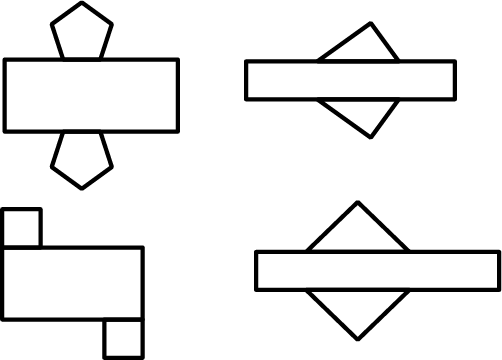Lesson 26
Building Prisms
Let’s build a triangular prism from scratch.
26.1: Nets
Here are some nets for various prisms.

-
What would each net look like when folded?
- What do you notice about the nets?
26.2: Making the Base
The base of a triangular prism has one side that is 7 cm long, one side that is 5.5 cm long, and one angle that measures \(45^\circ\).
-
Draw as many different triangles as you can with these given measurements.
-
Select one of the triangles you have drawn. Measure and calculate to approximate its area. Explain or show your reasoning.
26.3: Making the Prism
Your teacher will give you an incomplete net. Follow these instructions to complete the net and assemble the triangular prism:
- Draw an identical copy of the triangle you selected in the previous activity along the top of the rectangle, with one vertex on point \(A\).
- Draw another copy of your triangle, flipped upside down, along the bottom of the rectangle, with one vertex on point \(C\).
- Determine how long the rectangle needs to be to wrap all the way around your triangular bases. Pause here so your teacher can review your work.
- Cut out and assemble your net.
After you finish assembling your triangular prism, answer these questions. Explain or show your reasoning.
- What is the volume of your prism?
-
What is the surface area of your prism?
-
Stand your prism up so it is sitting on its triangular base.
- If you were to cut your prism in half horizontally, what shape would the cross section be?
- If you were to cut your prism in half vertically, what shape would the cross section be?
26.4: Combining Prisms
- Compare your prism with your partner’s prism. What is the same? What is different?
- Find a way you can put your prism and your partner’s prism together to make one new, larger prism. Describe your new prism.
- Draw the base of your new prism and label the lengths of the sides.
-
As you answer these questions about your new prism, look for ways you can use your calculations from the previous activity to help you. Explain or show your reasoning.
- What is the area of its base?
- What is its height?
- What is its volume?
- What is its surface area?
How many identical copies of your prism would it take you to put together a new larger prism in which every dimension was twice as long?